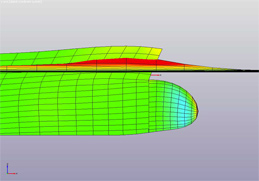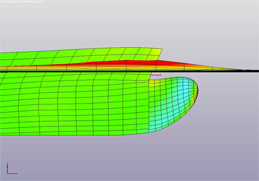Optimization of a bulb for wave resistance
The bulbous bow is considered an effective means to reduce the resistance of a ship. A bulb reduces wave resistance by lowering the bow wave system and it also reduces the viscous resistance by smoothing the flow around the forebody. For slender fast hull forms such as Ro-Ro ships the primary reduction in resistance is due to cancellations in the bow wave system, which is accomplished by interference between waves generated by the bulb and the ship. The cancellation depends on the phase and amplitude of each wave system. At optimum conditions the two waves may cancel each other out totally. The phase difference of the two wave systems is determined by the location of the bulb, and the amplitude of the bulb’s waves are determined by the bulb volume. However, designing an optimum bulb is still a difficult task because no design tool is available for common design problems, such as how large bulb should be and where the bulb should be located. The present leaflet demonstrates how the designer can make an optimum bulb design using SHIPFLOW FRIENDSHIP Design Package efficiently and effectively.
Case description
A very common SHIPFLOW application is a fore body and bulb optimization. A typical design procedure for a bulb modification is presented using a Ro-Ro ship sailing at Froude number of 0.28. The investigation includes a vertical and a longitudinal shift of the bulb.
Computations
The potential flow solver XPAN is used to predict the wave pattern and calculate the wave resistance. The bulb shape is modified with Delta Shift functions in the vertical and longitudinal directions using smooth parametrized curves to keep a smooth bulb shape. The Nelder Mead Simplex method is utilized to find the optimum solution within the constraints.
Results
In the GUI the results of the optimization are summarized in a tabular form and also for each individual SHIPFLOW run the full standard OUTPUT file is available together with the potential flow solution that can be visualized in the 3D View. The variant comparison can be performed by browsing through the design tree and displaying the resulting wave pattern side by side. A more detailed analysis is possible by using the requested data summarized in the table (see the picture below) or creating graphs where design variables and parameters can be plotted.
The result of the optimization showed significant wave change when the length of the bulb was varied. A very long bulb was found more effective in wave cancellation, however due to the usually restricted over all length of the ship and the increase of the wetted area the length has to be constrained and the vertical position, volume and form has to be investigated in more detail. In the pictures below two designs with different vertical position of the bulb tip are compared. The bulb which is nearly surface piercing at zero speed shows a more positive effect on the resistance reduction and also the bow wave height is noticeably decreased.


CONCLUDING REMARKS
Global and local hull shape optimization is now possible with the new capabilities included in SHIPFLOW FRIENDSHIP Design Package. This advanced and complete hull design environment is a seamless integration of SHIPFLOW CFD code and FRIENDSHIP Framework engineering software providing graphical user interface and tools for hull form design, modifications and optimization. For further information please visit www.flowtech.se and www.friendship-systems.com.


